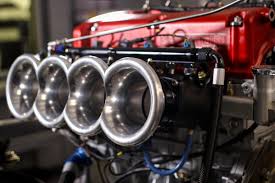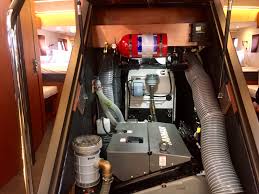How to Increase Your Horsepower
Squeeze extra power from your vehicle’s
engine.
Modern cars are quite fast right off the
showroom floor, but that doesn’t stop many enthusiasts from trying to squeeze
every bit of performance out of them. From mild to wild, there are a variety of
ways to add some extra power to your vehicle. Here are some popular methods to
increase your engine’s horsepower.
Cold Air Intake
Upgrading your vehicle’s intake is one of
the easier methods for unlocking some extra horsepower. In fairness, factory
intake setups are generally quite effective, but there are some cases where an
engine will benefit from an aftermarket intake. These setups utilize a
free-flowing air filter, allowing the engine to breathe easier. In order to
function properly, an aftermarket air intake needs a proper heat shield;
otherwise, it will suck hot air from the engine compartment, negating any
performance gains.
Performance Exhaust
A performance exhaust is one of the most
popular modifications for enthusiasts. Just like a performance intake, a
performance exhaust is designed to flow better than a stock setup. Aftermarket
exhausts are usually louder than stock but may also save a few pounds.
Depending on your vehicle application, additional exhaust components (such as a
downpipe or a set of headers) can maximize any exhaust system gains.
Software
This is probably the most cost-effective
way to add power to a modern car. When a manufacturer produces a vehicle, the
ECU (engine control unit) is often tuned conservatively to allow for lower
grade fuels and to minimize some of the stress on internal engine components.
Aftermarket software (also referred to as a
“flash”) is designed to take full advantage of your engine by adjusting the
ignition timing to smooth out power delivery (often requiring premium
gasoline). Many turbocharged vehicles see considerable power gains from ECU
tuning, as it also allows the turbocharger to produce more boost pressure,
which equates to more power.
If you choose to go the software route, be
sure to purchase from a reputable tuner, as engines are very sensitive to
changes. Tunes are often available in “stages,” meaning you’ll need to select
the tune that best suits your engine’s current configuration (stock vs.
supporting modifications).

Forced Induction
If your vehicle’s engine is naturally
aspirated, forced induction will provide some hefty power gains. Forced
induction can come in the form of a turbocharger or a supercharger. Turbochargers
generate power by using leftover exhaust gases to spin a turbine wheel, which
forces more air into the engine. With more air, the engine can burn extra fuel
to produce more power.
A supercharger works similarly to a
turbocharger in that it forces more air into the engine. However, a supercharger
is belt driven, so it requires some engine power to operate. The benefit of a
supercharger is that it has an instantaneous response, whereas a turbocharger
may have a bit of lag while it builds boost.
Since adding forced induction puts more
strain on your vehicle’s engine and drivetrain, you may need supporting
modifications, such as a heavier duty clutch or cooling system. This will vary
by vehicle application, but it’s worth keeping in mind.
Performance Engine Build
If you’re dead set on getting the most
performance out of your existing engine, then you’ll need to deep dive into a
performance engine build. This requires rebuilding the engine with performance
parts such as beefed up cylinder heads, upgraded pistons, and a stroker
crankshaft to name a few. If you’re not comfortable disassembling an engine,
then this is best left to an experienced engine builder.
Engine Conversion
If you’ve run out of bolt-on power upgrades
and don’t want to tear your existing engine apart to modify the internals, then
an engine conversion may be the next logical step. This is not for the faint of
heart, but swapping in a more powerful motor can be an effective way to increase
your vehicle’s horsepower. Some engine swaps are fairly plug-and-play, while
others may require extensive fabrication. It’s best to do some research or talk
to someone who has performed a similar engine swap to get a sense of what’s
truly involved with an engine conversion.

Ways To Increase Engine Power
This post is in response to Ian Wright’s
guide to car modifying. He covered a lot of bases, but engine performance
wasn’t really one of them. So I decided I would do that, because an engine is
arguably the most significant/important part of a car.
Engine Rebuild
If you have a high mileage engine and want
it to make more power, you should consider rebuilding it before you throw speed
parts at it. Replacing bearings, piston rings, machining the crankshaft and
cylinder walls can really make a difference. A freshly rebuilt engine will be
making more power than the same engine that’s been chugging along for hundreds
of thousands of miles without any major work done to it.
Free Flowing Exhaust System
An internal combustion engine may be one of
the mechanical objects that comes closest to resembling a human body/organ
system. One big reason being is that an ICE needs an efficient way to breath in
order to maximize it’s performance; that’s where a good exhaust system comes
in. Uncorking your engine’s exhaust system will make it louder, more powerful
and some believe more fuel efficient.
Increased Bore And Stroke
If you want an engine with more
displacement but don’t want to do an engine swap, increasing the bore and
stroke of the engine is a good option. What it does is increase the distance
the pistons travel up and down in the cylinder walls and the size of the
cylinder walls and pistons. Long story short your engine can intake and
detonate a lot more fuel. How it’s done is by changing the crankshaft and
connecting rods for stroking and increased bore and piston diameter for boring.

Improved Air Intake System
A good percent of factory air intake
systems are built with production cost in mind, not performance. Whether or not
an aftermarket air intake system will improve your engine’s power is dependent
on the car that you are modifying. Some stock air intake systems are hard to
improve on where an aftermarket one might actually decrease power instead of
increasing it. A third possibility is that the system will have very little to
no gains in power.
Better Fuel Delivery
If you have more than enough air going into
your engine, try looking at increasing your fuel flow. You can increase it with
a swanky Holley carburetor, a racing fuel pump or fuel injectors from HKS.
Aftermarket Camshafts
Camshafts control how much the intake and
exhaust valves lift off the cylinder head and how long they are lifted off the
cylinder heads. By putting an aftermarket camshaft in your engine, you can see
some big power increases because camshafts play a big role in engine breathing.
Tuning
Sometimes, you can make power with a stock
engine just by tweaking it a little. Whether it’s upping the boost of a
turbocharged engine, tuning for race gas or E85 or advancing ignition timing,
most factory engines have some room to grow power wise. Tuning has more
significant gains with boosted engines compared with naturally aspirated
engines.
Boost And Nitrous
While this engine modification can yield
the most results, it can also be the most expensive and dangerous. You can
increase your engine power drastically, but supercharger and turbocharger kits
can easily cost 4 figures. Another potential cost is fortifying your engine to
take the boost/nitrous. It’s big risk, big reward with boost and nitrous, the
question is, do you want to take it?
How to Rebuild 4 Cylinder Engines for More
Horsepower
When rebuilding an engine, you can opt to
have additional work done to improve engine performance over stock levels. Your
upgrade path will differ based on whether you want a naturally aspirated or
turbocharged engine. In either case, more horsepower is developed by machining
work on the head, replacement of valves and valve springs, raising or lowering
engine compression, and replacement of bottom-end components such as rods and
crank. The exacting nature of detailed head work is challenging and best left
to a professional shop, but bottom-end and basic head-work can be accomplished
by the dedicated home mechanic.
Step 1
Port and polish the intake runners, and
gasket match the exhaust ports. An engine head is nothing moire than a series
of gas channels, directing air in and out of the engine. Modern engines feature
cast components, and these often come with small blemishes and rough areas
embedded in the metal. Using a die grinder with a carbide tip, you can clean up
the intake ports, polishing them to a smooth shine. On the exhaust side, bolt
up the exhaust manifold gasket and use the die grinder to make sure the exhaust
ports fully match the gasket shape and size, as these ports are typically
slightly smaller.
Step 2
Replace the valves and valve springs with
aftermarket units, or have a shop perform a valve job. The shape of the valves
affects performance, and by removing material at the top of the valve’s cap,
you can improve airflow since you are reducing obstruction in the air channel.
In addition to the valves, using titanium or high-strength valve springs will
allow you to increase the redline on your engine, increasing your power band.
Step 3
Installer a thicker or thinner head gasket.
This is an easy way to make more power depending upon whether you are naturally
aspirated, or turbocharged. For a naturally aspirated engine, a thinner head
gasket — or having a professional shop shave the head — will increase
compression, and thus increase power. On a turbocharged engine, a thicker head
gasket will lower compression, which allows the engine to safely handle more
boost.
Replace the crankshaft, rods and pistons
with forged aftermarket units. Most engines come with cast internal components,
by swapping to forge internals, the rods and pistons become far more heat
resistant, which allows you to increase compression and timing in a naturally
aspirated engine, or increase boost and timing in a turbocharged engine. In
addition to more heat resistance, the forged pieces may be lighter than stock
allowing for better throttle response. Some aftermarket companies produce
stroker kits, which are complete bottom-end assemblies that allow you to
increase the displacement of your engine via a revised crankshaft, rods and
pistons. Stroker kits might allow you to turn a 1.8 liter engine into a 2.0
liter engine, which will generate more power.